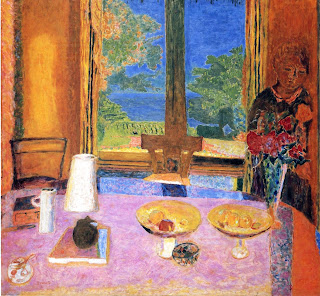Pierre Bonnard (1867-1947) qualified as a barrister in Paris in 1889 but his main interest was in art, having already enrolled in the Académie Julian in 1887. While there he was encouraged by Paul Sérusier to adopt a style of painting that used pure colour in flat areas with strong outlines, as developed by Paul Gauguin. Bonnard became a member of the “Nabis brotherhood” of painters (Nabi being Hebrew for “prophet”), led by Sérusier and which included Maurice Denis and Edouard Vuillard, that was devoted to this approach as an alternative to Impressionism.
Bonnard was also attracted to the simple formalism of Japanese art, which in turn led him to explore the possibilities of decorative art in media such as ceramics, furniture, fans, theatrical scenery and posters. It was Bonnard’s success in the last of these fields that inspired Henri de Toulouse-Lautrec to devote his energies in that direction.
The Nabis brotherhood split up in 1900, with Bonnard and Vuillard being less interested in the mystical and symbolist preoccupations of their fellow members. They preferred to concentrate on natural and domestic subjects for their art, and to incorporate Impressionist tendencies in their painting style. However, the Nabis use of areas of strong colour was a lasting legacy in their work.
Bonnard moved on to develop a style that made use of framing within his paintings, the frames being distinct vertical and horizontal lines that could be pieces of furniture, doors or window frames. He was very interested in the possibilities of photography, and the use of framing derived largely from that interest.
He moved to the south of France in 1910 and spent most of the rest of his life there. This move brought the importance of light and colour to his attention, with the greater intensity of the light in that region making the colours of all objects more vivid.
Bonnard painted “Dining Room on the Garden” in 1934-5, when he was a widely recognised and successful artist. It is a typical example of his mature style and his preferred subject matter, namely a domestic scene. In this case, the room is in a seaside villa where the artist and his family spent a summer.
Bonnard’s wife Marthe, who had formerly been his regular nude model, is pictured to the right of a window. She is dressed elegantly in dark brown clothes but her face is painted in a reddish-brown colour that is virtually identical to that of the wall behind her, so that she seems to fade into the background as being welded to the scene of domestic regularity. Her function is to form part of the frame in that she continues the upward line of a vase of red flowers, set on the table, which partially obscures her.
The focus of the painting is the window frame, with a thick central vertical division, through which can be seen part of the garden, two somewhat stylized trees, and the distant sea, above which is a bright blue Mediterranean sky.
Inside, the horizontal frame is provided by the table, with its pinkish-purple cloth, on which are various objects including a milk jug and fruit bowls.
The immediate impression given by the painting is of strong zones of colour that set each other in context. There is a vivid yellow patch, possibly of reflected sunlight, on the wall to the left of the window, which contrasts with the intense blue of the sky and the bright red of the table edge on the right-hand side. The early influence of Gauguin seems to have been maintained more than 30 years after the Nabis group members went their separate ways.
“Dining Room on the Garden”, with its strong lines and colours, speaks of order and stability. This is the work of an artist who is happy with his life and wants nothing more than to live out his days in the company of his devoted wife, in beautiful surroundings, and to have all the comforts of domestic life close to hand.
“Dining Room on the Garden” is in the Guggenheim Museum, New York.
© John
Welford

No comments:
Post a Comment